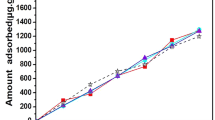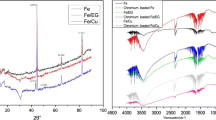Abstract
The role of adsorbed and structural Fe3+ in palygorskite and sepiolite with respect to the oxidation of hydrocortisone in aqueous suspension has been evaluated using electron spin resonance and UV-visible spectroscopy. Natural surface-adsorbed Fe3+ showed an important activity in the oxidation process, although smaller than octahedral Fe3+. The kinetics of oxidative degradation of hydrocortisone by palygorskite appear to be composed of two apparent first order reactions which may be associated with two kinds of sites for Fe in palygorskite. The lower oxidizing power of sepiolite for hydrocortisone degradation is due to its very low Fe3+ content.
Резюме
Оценивалась роль адсорбированного и структурного Fe3+ в палыгорските и сепиолите по отношению к окислению гидрокортизона в водных растворах путем электронного спинового резонанса и Уф-видимой спектроскопии. Естественные Fe3+, адсорбированные на поверхности, показали значительную, хотя меньшую, чем октаэдрические Fe3+, активность в процессе окисления. Кинетика окислительной деградации гидрокортизона палыгорскитом, по-видимому, состоит из двух кажущихся первого порядка реакций, которые могут быть связаны с двумя типами мест для Fе в палыгорските. Низшая окислительная сила сепиолита для деградации гидрокортизона обусловлена его низким содержанием Fe3+. [E.C.]
Resümee
Der Einfluß von Fe3+, das an Palygorskit und Sepiolith adsorbiert ist oder sich in deren Struktur befindet, wurde im Hinblick auf die Oxidation von Hydrocortison in wässriger Subspension mittels Elektronenspinresonanz und UV-VIS-Spektroskopie untersucht. Natürliches, an der Oberfläche adsorbiertes Fe3+ zeigt einen erheblichen Einfluß auf den Oxidationsprozeß, der jedoch kleiner ist als der von oktaedrischem Fe3+. Die Kinetik der oxidativen Degradation von Hydrocortison durch Palygorskit scheint aus zwei Reaktionen erster Ordnung zu bestehen, die anscheinend mit zwei Arten von Fe-Plätzen im Palygorskit zusammenhängen. Das geringe Oxidationsvermögen von Sepiolith bei der Hydrocortison-Degradation hängt mit dessen sehr geringem Fe3+-Gehalt zusammen. [U.W.]
Résumé
Le rôle de Fe3+ adsorbé et structural dans la patygorskite et la sépiolite vis à vis de l’oxidation de l’hydrocortisone en suspension aqueuse a été evalué en utilisant la résonnance à spin d’électrons et la spectroscopie UV-visible. Le Fe3+ naturel adsorbé à la surface a montré une activité importante dans le procédé d’oxidation, quoique plus petite que Fe3+ octaédral. La kinétique de dégradation oxidative de l’hydrocortisone par la palygorskite semble être composée de deux réactions de premier ordre qui pourraient être associées à deux sourtes de sites pour Fe dans la palygorskite. La capacité d’oxidation moindre de la sépiolite pour la dégradation de l’hydrocortisone est due à son très has contenu en Fe3+. [D.J.]
Similar content being viewed by others
References
Angel, B. R. and Hall, P. L. (1972) Electron spin resonance studies in kaolin: In Proc. Int. Clay Conf., Madrid, 1972, J. M. Serratosa, ed., Div. Ciencias C.S.I.C., Madrid, 47–59.
Angel, B. R. and Vincent, W. E. J. (1978) Electron spin resonance studies of iron oxides associated with the surface of kaolins: Clays & Clay Mineras 26, 263–272.
Berkheiser, V. and Mortland, M. M. (1975) Variability in exchange ion position in smectite: dependence on the in-terlayer solvent: Clays & Clay Minerals 23, 404–410.
Cornejo, J., Hermosin, M. C, White, J. L., Peck, G. E., and Hem, S. L. (1980) Oxidative degradation of hydrocortisone in the presence of attapulgite: J. Pharm. Sci. 69, 945–948.
Goodman, B. A. (1978) An investigation by Mossbauer and EPR spectroscopy of the possible presence of iron-rich impurity phases in some montmorillonites: Clay Miner. 13, 351–356.
Hermosin, M. C, Cornejo, J., White, J. L., and Hem, S. L. (1981) Sepiolite: a potential excipient for drugs subject to oxidative degradation: J. Pharm. Sci. 70, 189–192.
Jackson, M. L. (1956) Soil Chemical Analysis. Advanced Course: 4th printing, 1968, Published by the author, University of Wisconsin, Madison, Wisconsin, 47–58.
Karickhoff, S. W. and Bailey, G. W. (1973) Optical absorption spectra of clay minerals: Clays & Clay Minerals 21, 59–79.
McBride, M. B. (1979) Reactivity of adsorbed and structural iron in hectorite as indicated by oxidation of benzidine: Clays & Clay Minerals 27, 224–230.
McBride, M. B., Mortland, M. M., and Pinnavaia, T. J. (1975) Exchange ion position in smectite: effects on electron spin resonance of structural iron: Clays & Clay Minerals 23, 162–164.
Miller, J. G., Haden, W. L., and Oulton, T. D. (1964) Oxidizing power of attapulgite clay: In Clays and Clay Minerals, Proc. 12th Natl. Conf., Atlanta, Georgia, 1963, W. F. Bradley, ed., Pergamon Press, New York, 381–395.
Pitman, I. H., Higuchi, T., Alton, M., and Wiley, J. (1972) Deuterium isotope effects on degradation of hydrocortisone in aqueous solution: J. Pharm. Sci. 61, 918–920.
Solomon, D. H., Loft, D. C, and Swift, A. J. (1968) Reactions catalyzed by minerals. IV: The mechanism of the benzidine blue reaction in silicate minerals: Clay Miner. 7, 389–397.
Takubo, T., Tadaka, T., and Sanwai, T. (1962) Stability of cortisone and hydrocortisone: Yakuzaigaku 22, 67–70.
Theng, B. K. G. (1974) The Chemistry of Clay-Organic Reactions: Adam Hilger, London, 261–291.
Author information
Authors and Affiliations
Rights and permissions
About this article
Cite this article
Cornejo, J., Hermosin, M.C., White, J.L. et al. Role of Ferric Iron in the Oxidation of Hydrocortisone by Sepiolite and Palygorskite. Clays Clay Miner. 31, 109–112 (1983). https://doi.org/10.1346/CCMN.1983.0310204
Received:
Accepted:
Published:
Issue Date:
DOI: https://doi.org/10.1346/CCMN.1983.0310204




